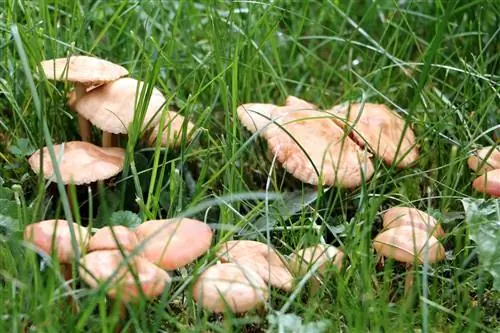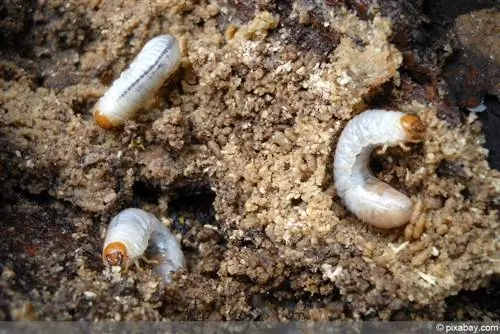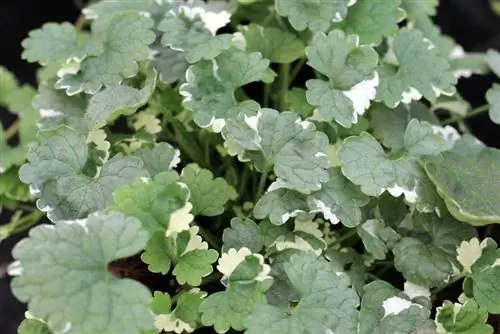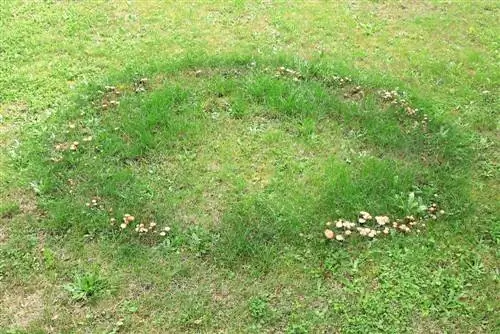- Author admin [email protected].
- Public 2023-12-17 03:39.
- Last modified 2025-01-24 12:45.
Grubs can cause a lot of damage to many lawns if they occur in large numbers because they feed on the roots of the grass. However, the damage is usually only noticeable when the lawn has brown spots. They can live in the soil in the larval stage for up to four years. When they pupate, they can still be found in the ground for some time. We have some tips and tricks for you on how you can get rid of the grubs in an environmentally friendly way.
Distinguishing grubs
Not every grub is harmful to the lawn, for example the rhinoceros beetle and the rose beetle. These beetles are protected. The rose beetle larvae, for example, are important beneficial insects for the compost heap. The grubs of May and June beetles can reach a length of five to six centimeters. They are about the same thickness at the back and front and have very long, strong legs on the head. The head and legs are darker in color than the light, yellowish to brownish rest of the larva and, depending on the larval stage, take on an orange, brown to black color. If you have a lot of grubs in your lawn and don't know exactly which beetle larvae they are, you can use the following test to find out which grubs they are:
Place the grubs on a flat surface, for example on a patio tile or on a wooden board. May and June beetles try to get around on their stomachs or lying on their sides. The rose beetle grub, on the other hand, first turns on its back and then crawls away like a caterpillar. In addition, its abdomen is significantly thicker than its front part.
Use of nematodes
In large lawns, collecting the grubs is very laborious and actually almost impossible. The entire lawn often has to be freshly sown. However, useful nematodes (roundworms) can help you combat a massive grub infestation. Predatory HM nematodes (Heterorhabditis sp.) are used for the larvae of dung beetles, garden leaf beetles, May and June beetles, which are also often used in the control of black weevil larvae. You can get the nematodes from various beneficial insect companies, where you can also send the grubs for identification. This way you can be completely sure that you are using the right nematodes. Always mix the contents of the package with the nematodes according to the instructions for use and use a watering can to apply them to the lawn. Pay attention to the soil temperature. The nematodes work most successfully at around 12 °C. The best time for using nematodes outdoors is between April/May and September and of course depends on the weather. Approximately 10 million nematodes are required for a lawn area of approximately 20 square meters.
Tip:
After treatment, keep the lawn moist for about six to eight weeks so that the nematodes can take full effect.
Use of grub traps
You can also set traps with nutrient-rich contents for annual grubs. In such a way that they are distracted from the lawn. The best way to do this is to take large planters or water buckets and fill them with horse manure or compost. Leave an upper edge about a hand's width free. Then dig the buckets or planters approx. 40 to 50 centimeters deep into the garden soil and fill the top with soil. Carefully mark the locations of buried traps so you can find the buckets later. To mark it, you can use sticks or stones that you place around the buckets.
Tip:
It is best to bury the grub traps in the ground in spring and only remove them a year later. Then refill the buckets and start the process again.
Reserve garden area for grubs
Grubs can hardly be avoided in a natural garden and are also on the menu of hedgehogs etc. It is therefore advisable to specifically lure the grubs into a garden area that is best located in the compost area and allowed to grow wild. Preferably let dandelions grow, whose roots are only too happy to be eaten by grubs. Or put horse manure in the corner so that the grubs have no choice but to come here.
Tip:
Limit the grubs' area with lawn edges, metal sheets or buried grids so that they cannot migrate to your lawn and also stay away from the rest of the garden. Additionally, install solar-powered garden lights as the beetles are attracted to the light. Then they prefer to lay their eggs in this area.
Attracting beneficial insects to the garden
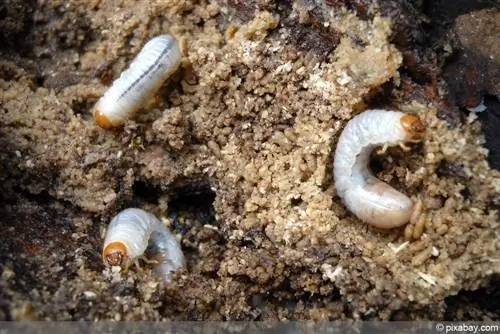
Martens, hedgehogs, birds and mice love to eat the grubs and therefore often dig for them in the ground. You can see this in your garden by the many holes after heavy rainfall, when the grubs are washed to the surface of the ground and can then be more easily dug out by hedgehogs and the like. Allow the useful animals free rein and do not close the holes tightly. The animals are hard-working garden helpers and save you from having to dig regularly. In addition, digging aerates the soil. It is better to set up natural corners in your garden for them, where you and your family have no access and where the useful animals can develop and reproduce freely. These include, for example, bird protection hedges and piles of brushwood. But also provide accessible drinking troughs and feeding stations that you can refill again and again.
Verticutting
Regular scarifying loosens the soil in the lawn and makes it more difficult for the grubs to settle there. Therefore, scarify regularly to prevent a severe infestation of grubs.
Plants against grubs
There are some plants that are toxic to grubs and that you can use to reduce an infestation, for example geranium and delphinium. Therefore, plant these plants in large numbers near your lawn or dig up shredded plant parts into the lawn after scarifying or mulch with them.
Garlic tea
Garlic tea, which you distribute over the entire lawn, is a very good preventative measure against the infestation of your lawn with grubs. The grubs are deterred by the garlic's active ingredients.
Conclusion
Grubs in the lawn can cause a lot of damage once they are in the ground in large numbers. However, you can counteract this in advance by attracting beneficial insects to your garden, driving away the grubs with garlic, scarifying regularly or reserving an overgrown corner in the garden for the grubs. If the infestation is very severe, nematodes and traps are helpful. But remember that there are a few grubs in every good garden soil. So if you find a grub here or there while weeding, just put it in the compost with the weeds. The birds are happy when they can pick it out there.


